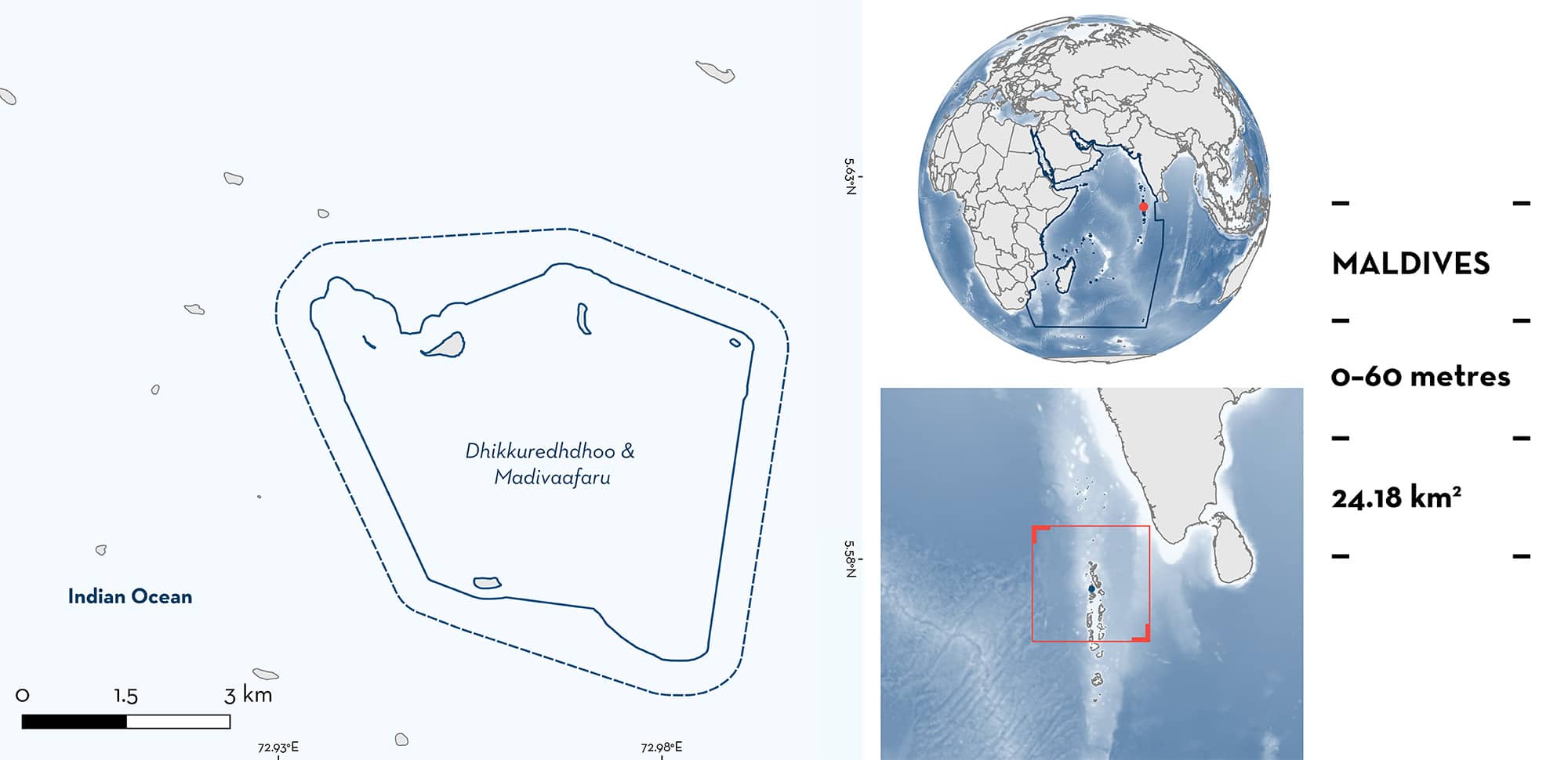ISRA FACTSHEETS
ISRA FACTSHEETS
WESTERN INDIAN OCEAN REGION
Dhikkuredhdhoo & Madivaafaru
Summary
Dhikkuredhdhoo & Madivaafaru is located in central Raa Atoll in the northern Maldives. This area comprises four islands, one sand bank, and multiple underwater reef pinnacles of various sizes. During the southwest monsoon (May to November) productivity increases, enhancing zooplankton abundance. Within this area there are: threatened species and feeding areas (Reef Manta Ray Mobula alfredi).
Download factsheet
Dhikkuredhdhoo & Madivaafaru
DESCRIPTION OF HABITAT
Dhikkuredhdhoo & Madivaafaru is located in central Raa Atoll in the northern Maldives. The area comprises four islands, one sand bank, and multiple underwater reef pinnacles, locally known as thilas, of various sizes.
This area is influenced by the South Asian Monsoon (Gischler et al. 2013). Productivity in this region peaks during the southwest monsoon (May to November) (J Haines pers. obs. 2019–2022), when the weather is typically characterised by more rain and cloud cover, along with reduced underwater visibility and stronger wind speeds resulting in rougher seas (Stevens & Froman 2019). The strong monsoonal winds create oceanic currents that flow from the southwest towards the northeast during the southwest monsoon. The central reefs of this area act as a barrier to these currents, displacing the water as it flows through and around the atoll, creating deepwater upwellings that bring nutrient rich water into the euphotic zone and phytoplankton blooms, therefore, increasing zooplankton abundance (Anderson et al. 2011; Stewart et al. 2019).
Dhikkuredhdhoo is the southernmost part of the area, comprised of a large sand bank surrounded by a shallow lagoon and oval shaped reef, sloping down to a sandy bottom of ~10 m, with a finger shaped underwater reef pinnacle that reaches depths of ~20 m. To the west is Dhikkuredhdhoo Island and several small rounded underwater reef pinnacles with maximum depths of ~40 m between them.
Madivaafaru describes the northernmost part of the area, which is comprised of three islands and multiple underwater reef pinnacles. Muravandhoo Thila is a deeper underwater reef pinnacle with a top of ~15 m and steep edges reaching depths of ~40 m. In the centre is Madivaafaru Island surrounded by a shallow top reef of ~3 m that reaches depths of ~40 m on the outside. To the eastern side of the area is Boduhaiykodi Island and Kudahaiykodi, a very shallow reef pinnacle that protrudes the surface of the water. These two reefs are the smallest in the area with varying depths of ~5–50 m. Separating the northern and southern parts of the area is a more open ocean area, reaching depths of ~60 m.
This Important Shark and Ray Area is benthopelagic and is delineated from inshore and surface waters (0 m) to 60 m based on the bathymetry of the area.
CRITERION A
VULNERABILITY
The one Qualifying Species within the area is considered threatened with extinction according to the IUCN Red List of Threatened SpeciesTM. The Reef Manta Ray is assessed as Vulnerable (Marshall et al. 2022).
CRITERION C
SUB-CRITERION C2 – FEEDING AREAS
Dhikkuredhdhoo & Madivaafaru is an important feeding area for one ray species.
This area holds regular and predictable aggregations of feeding Reef Manta Rays. Between 2019–2023, 111 underwater visual census surveys were conducted by snorkellers and divers. A total of 370 sightings of 248 individuals were observed using five feeding strategies (straight, surface, chain, piggyback, and cyclone) to strain zooplankton prey over their specialised gill plates (Stevens 2016; J Haines unpubl. data 2019–2022). The largest aggregation of feeding Reef Manta Rays comprised 56 individuals, although aggregations of 15–20 individuals were more regular. These feeding aggregations are observed predictably during September to November, as the productivity of the area is strongly influenced by the southwest monsoon. Between 2019–2022, this area was considered the most important feeding area in Raa Atoll due to the highest number of feeding Reef Manta Rays sighted (IDtheManta unpubl. data 2022).
Download factsheet
SUBMIT A REQUEST
ISRA SPATIAL LAYER REQUEST
To make a request to download the ISRA Layer in either a GIS compatible Shapefile (.shp) or Google Earth compatible Keyhole Markup Language Zipped file (.kmz) please complete the following form. We will review your request and send the download details to you. We will endeavor to send you the requested files as soon as we can. However, please note that this is not an automated process, and before requests are responded to, they undergo internal review and authorization. As such, requests normally take 5–10 working days to process.
Should you have questions about the data or process, please do not hesitate to contact us.


